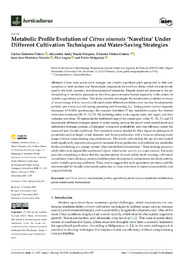Please use this identifier to cite or link to this item:
https://hdl.handle.net/11000/36673Full metadata record
| DC Field | Value | Language |
|---|---|---|
| dc.contributor.author | Giménez Valero, Carlos | - |
| dc.contributor.author | Maciá Vázquez, Alejandro Andy | - |
| dc.contributor.author | Núñez-Gómez, Dámaris | - |
| dc.contributor.author | Martinez Nicolas, Juan Jose | - |
| dc.contributor.author | Legua, Pilar | - |
| dc.contributor.author | Melgarejo Moreno, Pablo | - |
| dc.contributor.other | Departamentos de la UMH::Producción Vegetal y Microbiología | es_ES |
| dc.date.accessioned | 2025-05-23T11:27:48Z | - |
| dc.date.available | 2025-05-23T11:27:48Z | - |
| dc.date.created | 2024-11-07 | - |
| dc.identifier.citation | Horticulturae 2024, 10(11), 1187 | es_ES |
| dc.identifier.issn | 2311-7524 | - |
| dc.identifier.uri | https://hdl.handle.net/11000/36673 | - |
| dc.description.abstract | Citrus trees, particularly oranges, are a highly significant plant genus due to their consumption as fresh produce and the multiple compounds derived from them, which are extensively used in the food, cosmetic, and pharmaceutical industries. Despite recent advancements, the understanding of metabolic processes in the Citrus genus remains limited, especially in the context of variable agricultural practices. This study aimed to investigate the metabolomic evolution in leaves of sweet orange (Citrus sinensis) cultivated under different conditions over two key developmental periods: pre-winter (t1) and spring sprouting and flowering (t2). Using proton nuclear magnetic resonance (H-NMR) spectroscopy, this research identified 27 key metabolites across five distinct cultivation treatments (T0, T1, T2, T3, T4), including amino acids, organic acids, and sugars, and their variation over time. T0 represents the traditional crop of the control plot, while T1, T2, T3, and T4 incorporate different strategies aimed at water-saving, such as the use of weed control mesh and subsurface drainage systems, all designed to improve profitability and crop efficiency under the same soil and climatic conditions. The treatments were evaluated for their impact on plant growth parameters such as height, trunk diameter, and flower production, with a focus on reducing water usage without compromising crop performance. The results indicate that the use of weed control mesh significantly improves plant growth, increases flower production, and stabilizes key metabolite levels, contributing to a concept termed “plant metabolomic homeostasis.” These findings are particularly relevant in regions like southeastern Spain, where water scarcity is a major concern. The study provides compelling evidence that the implementation of weed control mesh in orange cultivation can enhance water efficiency, promote healthier plant development, and maintain metabolic stability under variable growing conditions. These results suggest that such agricultural practices could be recommended for broader commercial application in citrus cultivation to improve sustainability and crop profitability | es_ES |
| dc.format | application/pdf | es_ES |
| dc.format.extent | 23 | es_ES |
| dc.language.iso | eng | es_ES |
| dc.publisher | MDPI | es_ES |
| dc.rights | info:eu-repo/semantics/openAccess | es_ES |
| dc.rights | Attribution-NonCommercial-NoDerivatives 4.0 Internacional | * |
| dc.rights.uri | http://creativecommons.org/licenses/by-nc-nd/4.0/ | * |
| dc.subject | Leaf Citrus sinensis | es_ES |
| dc.subject | Metabolomic profile | es_ES |
| dc.subject | Agricultural plastic mulch | es_ES |
| dc.subject | Metabolite mobilization | es_ES |
| dc.subject | Plant metabolomic homeostasis | es_ES |
| dc.title | Metabolic Profile Evolution of Citrus sinensis ‘Navelina’ Under Different Cultivation Techniques and Water-Saving Strategies | es_ES |
| dc.type | info:eu-repo/semantics/article | es_ES |
| dc.relation.publisherversion | https://doi.org/10.3390/horticulturae10111187 | es_ES |

View/Open:
horticulturae-10-01187.pdf
853,41 kB
Adobe PDF
Share:
.png)
